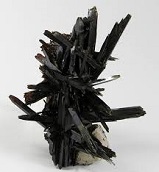
|
| Aegirines |
The name aegirine comes from the Teutonic god of the sea, Aegir, and was given when the first specimens of the mineral were discovered in Norway. Aegirine is difficult to distinguish from its close cousin augite. Under normal circumstances, the steep pyramids of aegirine are the only point of differentiation. Sometimes called acmite, from the Greek word for point, the steeply inclined pyramid on top of the prismatic crystals is very characteristic of aegirine. It forms tall, opaque or translucent, monument-like crystals that jut majestically out from their host rocks. These may be green to black to brownish-black in color.
Aegirine can assist in augmenting personal convictions and morals in order to do what is required. At its most basic, it will allow you to be yourself, dispensing with group pressures to conform. Emotional blockages are released to allow personal attitudes and opinions to surface.
Aegirine is also helpful in concentrating positive energy in an area, providing revitalization and mental stimulation, and focusing the energies of other minerals for unification, especially in healing.
Aegirine can assist in augmenting personal convictions and morals in order to do what is required. At its most basic, it will allow you to be yourself, dispensing with group pressures to conform. Emotional blockages are released to allow personal attitudes and opinions to surface.
Aegirine is also helpful in concentrating positive energy in an area, providing revitalization and mental stimulation, and focusing the energies of other minerals for unification, especially in healing.